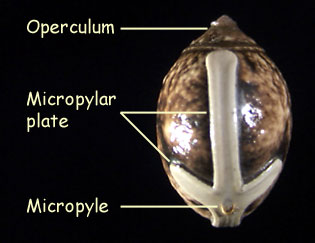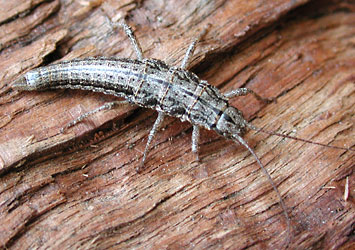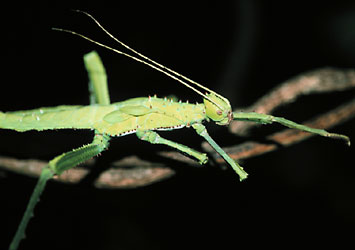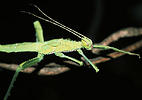Phasmida
Phasmids
Erich Tilgner


This tree diagram shows the relationships between several groups of organisms.
The root of the current tree connects the organisms featured in this tree to their containing group and the rest of the Tree of Life. The basal branching point in the tree represents the ancestor of the other groups in the tree. This ancestor diversified over time into several descendent subgroups, which are represented as internal nodes and terminal taxa to the right.

You can click on the root to travel down the Tree of Life all the way to the root of all Life, and you can click on the names of descendent subgroups to travel up the Tree of Life all the way to individual species.
For more information on ToL tree formatting, please see Interpreting the Tree or Classification. To learn more about phylogenetic trees, please visit our Phylogenetic Biology pages.
close boxTilgner (2002)
Introduction
Phasmida are terrestrial, nocturnal, phytophagous insects found in nearly all temperate and tropical ecosystems (Günther, 1953). Scientists have described over 3,000 species (Bragg, 1995), yet this figure is uncertain since some taxon names are synonyms, and many new species have not been formally described.
Characteristics
Phasmida are variable in appearance, ranging from relatively generalized forms, to some that are wonderful mimics of sticks and/or leaves. They display varying degrees of brachyptery, and can be winged or wingless. The tarsi have three articles in Timema Scudder and five in other Phasmida. Cerci are composed of one article, except for adult males of Timema which have a lobe on the right cercus.
Sexual dimorphism is usually extreme: the males are smaller and more gracile than the females. Reproduction is typically sexual, but parthenogenesis occurs frequently. The egg capsule is distinctively shaped, possessing a lid called the operculum and a micropylar plate (Sellick, 1997). Eggs are large and oftentimes highly sculptured resembling plant seeds. They are laid singly, and are dropped, flicked, buried, glued to a surface, or riveted to a leaf. Some species that drop the eggs rely on ants to disperse them in a process analogous to myrmecochory (Windsor et al., 1996). The entire life cycle from egg to adult can take from several months to several years depending on the species.


Egg capsule of Extatosoma popa. The nymph escapes by popping off the operculum. Photograph copyright © 2001, Erich Tilgner.
Phasmida possess several unique anatomical features that distinguish them from other Neoptera and indicate they are a monophyletic group (see Tilgner et al., 1999; 2002). For example:
- The labrum is emarginated.
- All possess a pair of exocrine glands inside the prothorax (in a few species, these glands can discharge an irritating, tear gas-like spray used for defense).
- The intestine has unique filament bearing glands.
- Thorax fused with abdominal sternum I
- The dorso-ventral muscles of the abdomen are numerous, short, and arranged in parallel.
- Males of many species possess a unique sclerite termed the vomer. This structure is located above the genitalia and permits the male to clasp the female.
Discussion of Phylogenetic Relationships
Timema is hypothesized to be the sister group to the remainder of Phasmida (Kristensen, 1975, Bradler 1999, Tilgner et al. 1999, Tilgner 2002), termed Euphasmida by Bradler (1999). Timema lack the autapomorphies of Euphasmida and possess traits found in other more distantly related Neoptera (Tilgner et al. 1999).
References
Bradler, S. 1999. The vomer of Timema Scudder, 1895 (Insecta: Phasmatodea) and its significance for phasmatodean phylogeny. Cour. Forschungstinst. Senckenb. 215:43-47.
Bragg, P.E. 1995. The Phasmid Database version 1.5. Phasmid Studies 3(2):41-42.
Günther, K. 1953. Über die taxonomische Gliederung und die geographische Verbreitung der Insektenordnung der Phasmatodea. Beiträge zur Entomol. 3:541-563.
Kristensen, N.P. 1975. Phylogeny of hexapod "orders." A critical review of recent accounts. Z. Zool. Syst. Evol.13:1-44.
Sellick, J.T.C. 1997. Descriptive terminology of the phasmid egg capsule, with an extended key to the phasmid genera based on egg structure. Syst. Entomol. 22:97-122.
Tilgner, E. H., Kiselyova, T. G., and McHugh, J. V. 1999. A morphological study of Timema cristinae Vickery with implications for the phylogenetics of Phasmida. Dtsche. Entomol. Z. 46(2):149-162.
Tilgner, E. H. 2002. Systematics of Phasmida. Ph.D. Dissertation, University of Georgia.
Wheeler, W.C. 1998. Sampling, groundplans, total evidence and the systematics of arthropods, In Fortey, R.A. & Thomas, R. H. (Eds.) Arthropod Relationships, Systematics Association special volume series 55, Chapman and Hall, London.
Windsor, D.M., Trapnell, D.W. and Amat, G. 1996. The egg capitulum of a neotropical walkingstick Calynda bicuspis, induces aboveground egg dispersal by the ponerine ant Ectatomma ruidum. J. Insect Behav. 9:353-362.
Information on the Internet
- Systematics of Phasmida. Full text of Erich Tilgner's Ph. D. Dissertation.
Title Illustrations

| Scientific Name | Timema dorotheae |
|---|---|
| Location | Hualapai Mountains, Arizona |
| Specimen Condition | Live Specimen |
| Sex | female |
| Image Use |
 This media file is licensed under the Creative Commons Attribution License - Version 3.0. This media file is licensed under the Creative Commons Attribution License - Version 3.0.
|
| Copyright |
© 2001 David R. Maddison

|
| Scientific Name | Heteropteryx dilatata |
|---|---|
| Specimen Condition | Live Specimen |
| Sex | Female |
| Life Cycle Stage | nymph |
| Image Use |
 This media file is licensed under the Creative Commons Attribution-NonCommercial License - Version 3.0. This media file is licensed under the Creative Commons Attribution-NonCommercial License - Version 3.0.
|
| Copyright |
© 2001
Erich Tilgner

|
About This Page
The author thanks Katja-Sabine Schulz and David R. Maddison for converting this page into the correct format for the Tree of Life. Tatiana Kiselyova kindly provided a review of this work.
Erich Tilgner

University of Georgia, Athens, GA, USA
Correspondence regarding this page should be directed to Erich Tilgner at
tilgner@alltel.net
Page copyright © 2001 Erich Tilgner
 Page: Tree of Life
Phasmida. Phasmids.
Authored by
Erich Tilgner.
The TEXT of this page is licensed under the
Creative Commons Attribution License - Version 3.0. Note that images and other media
featured on this page are each governed by their own license, and they may or may not be available
for reuse. Click on an image or a media link to access the media data window, which provides the
relevant licensing information. For the general terms and conditions of ToL material reuse and
redistribution, please see the Tree of Life Copyright
Policies.
Page: Tree of Life
Phasmida. Phasmids.
Authored by
Erich Tilgner.
The TEXT of this page is licensed under the
Creative Commons Attribution License - Version 3.0. Note that images and other media
featured on this page are each governed by their own license, and they may or may not be available
for reuse. Click on an image or a media link to access the media data window, which provides the
relevant licensing information. For the general terms and conditions of ToL material reuse and
redistribution, please see the Tree of Life Copyright
Policies.
- First online 14 August 2001
- Content changed 26 November 2006
Citing this page:
Tilgner, Erich. 2006. Phasmida. Phasmids. Version 26 November 2006. http://tolweb.org/Phasmida/8249/2006.11.26 in The Tree of Life Web Project, http://tolweb.org/










 Go to quick links
Go to quick search
Go to navigation for this section of the ToL site
Go to detailed links for the ToL site
Go to quick links
Go to quick search
Go to navigation for this section of the ToL site
Go to detailed links for the ToL site